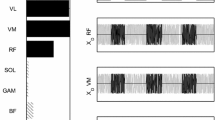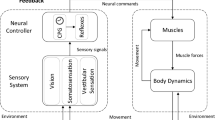Abstract.
(1) Rhythmic flexion-extensions of the hand and foot on one side were performed by ten male and nine female subjects. Limbs were rotated in the same direction (in-phase) or in opposite directions (anti-phase). Oscillation frequency ranged from 0.6 to 3.2 Hz for in-phase and to 2.2 Hz for anti-phase movements. In both genders, movement synchrony was more strictly maintained during anti-phase than during in-phase coupling. (2) EMG recordings showed that, in males, movement synchrony was achieved by activating hand movers in advance of foot movers. This phase advance increased as the oscillation frequency increased. In females, instead, muscles of the two limbs were activated almost simultaneously over most of the frequency range. Since the different timing of muscle activation in the two genders suggests that their limbs have different mechanical characteristics, the frequency response of each limb was estimated in either gender. The frequency response between 0.6 and 3.2 Hz was evaluated in five males and five females by measuring the phase delay between the onset of the EMG activity and the onset of the related movement, both when the limbs were moved in isolation and when they were coupled. (3) In uncoupled conditions, the hand and foot curves were roughly parallel in females, the phase delay being about 45° larger in the hand than in the foot. In males, the curves were also separated by 45° at the lowest frequencies but they further diverged when the frequency was raised, because of a faster increase in the phase delay in the hand than in the foot. These results indicate that, when the extremities have to be coupled, a nervous compensation is necessary and that it must be different in the two genders. (4) Analysis of the phase-response when limbs were coupled showed that synchrony was approached by two mechanisms: (a) an earlier EMG activation of the hand movers, preferentially utilised by males during in-phase coupling; and (b) a change in the viscoelastic properties of one extremity, which reduces (or eliminates) the difference between their frequency responses as well as between the EMG onsets of hand and foot movers. This second mechanism was utilised by both genders during anti-phase coupling.
Similar content being viewed by others
Author information
Authors and Affiliations
Additional information
Electronic Publication
Rights and permissions
About this article
Cite this article
Baldissera, F., Borroni, P. & Cavallari, P. Neural compensation for mechanical differences between hand and foot during coupled oscillations of the two segments. Exp Brain Res 133, 165–177 (2000). https://doi.org/10.1007/s002210000368
Received:
Accepted:
Issue Date:
DOI: https://doi.org/10.1007/s002210000368




